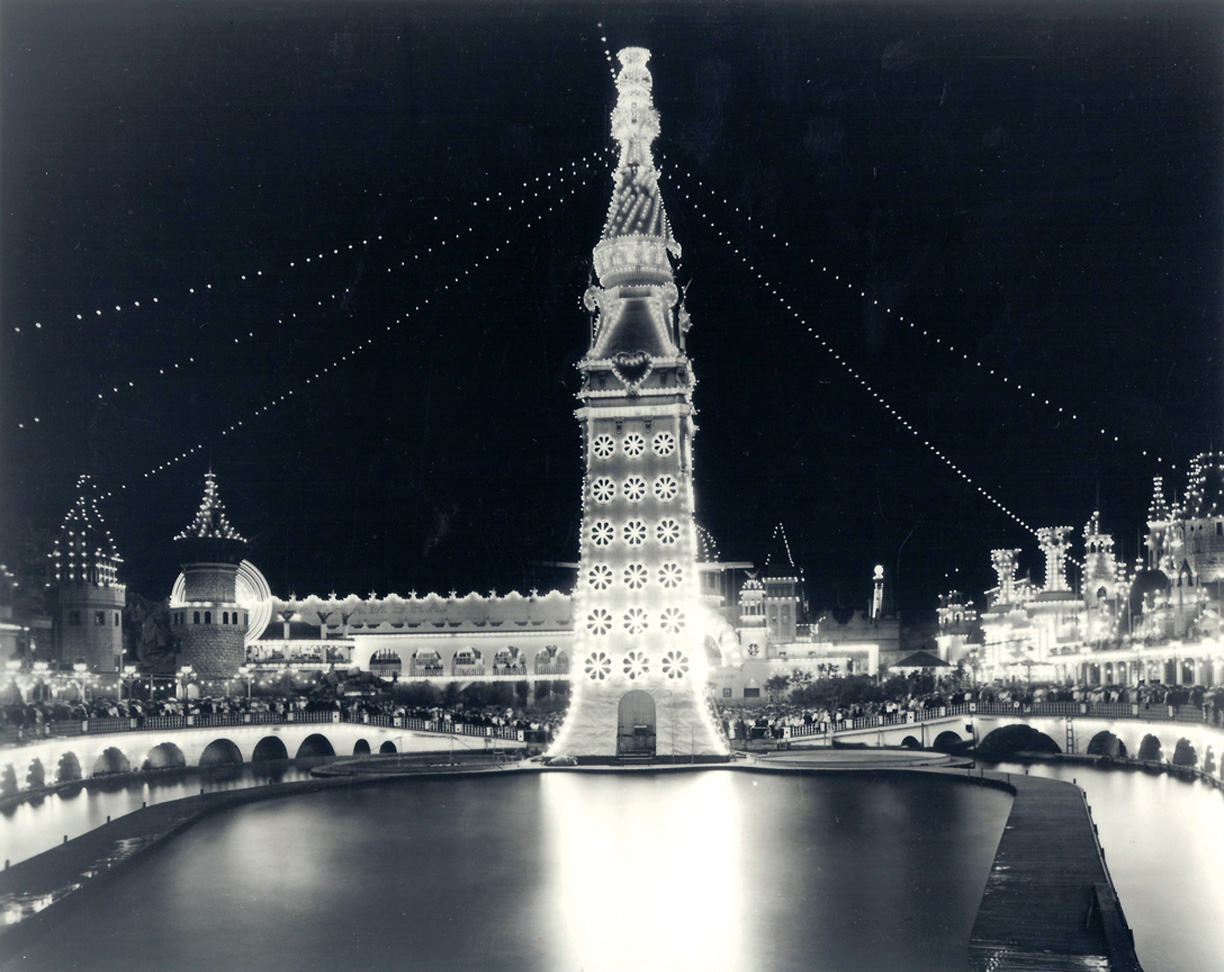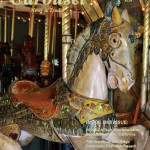A Romantic Amusement Park Vision Came To Life In Coney Island’s Original Luna Park
The Brain-Child of Visionaries Fred Thompson & Elmer “Skip” Dundy, Luna Park Opened May 16, 1903. The last survivor of the three great original Coney Island Parks, Luna Park burned down Aug. 12, 1944.
CONEY ISLAND’S GREATEST PARKS – Part 2 of 3:
Romantic Vision of the Original Luna Park.
By Paul and Nancy Brigandi
Special to The Carousel News & Trader
 Fredrick Thompson was born in Irontown, OH, on October 31, 1872. His father was an engineer and the family moved around a lot as he went from one job to another, continuing to pursue new and better opportunities. He did not like to be confined or disciplined and was continually defying his parents, several times trying to quit school. He finally succeeded in 1887. As a young child Fred spent a lot of his time around steel mills. He was attracted to the mechanics of the machinery and how they operated. His father taught his son in both the principles and ethics of solving mechanical problems.
Fredrick Thompson was born in Irontown, OH, on October 31, 1872. His father was an engineer and the family moved around a lot as he went from one job to another, continuing to pursue new and better opportunities. He did not like to be confined or disciplined and was continually defying his parents, several times trying to quit school. He finally succeeded in 1887. As a young child Fred spent a lot of his time around steel mills. He was attracted to the mechanics of the machinery and how they operated. His father taught his son in both the principles and ethics of solving mechanical problems.
 At a young age Thompson showed excellent drawing skills and he studied drafting at his uncles architecture office in Nashville in the 1890s. In 1891 he set up a business selling building materials, steel, and furniture to local contractors. This business became very lucrative as he made as much as $1,500 a month.
At a young age Thompson showed excellent drawing skills and he studied drafting at his uncles architecture office in Nashville in the 1890s. In 1891 he set up a business selling building materials, steel, and furniture to local contractors. This business became very lucrative as he made as much as $1,500 a month.
In 1893 at the age of 20 Thompson took a trip to the Columbian Exposition in Chicago in hopes of getting a job. He ended up getting a job as a janitor for a large machinery exhibit, and he became very handy at keeping their exhibit running smoothly. Eventually, Thompson was eventually put in charge. In 1896, the City of Nashville had a contest for would-be architects to create and design buildings for the 1897 Tennessee Centennial & International Exposition. Thompson’s imagination and creativity won him a $2,500 prize. His first attempt at designing an amusement ride, called the Giant See-Saw, was a feature at the 1897 exposition.
At the 1898 Trans-Centennial Exposition in Omaha, NE, Thompson put in an exhibit called “Heaven and Hell” which he shortly changed to “Darkness and Dawn” due to the complaint of local ministers. It was in Omaha that he met Elmer “Skip” Dundy, who had his own attractions called “The Mystic Garden” and “Havana and the Maine”.
Although Thompson decided not to stay for the second season, Dundy did. Unfortunately for Dundee, it proved to be a financial disaster with a loss of $46,000. However, he was still looking forward to another World’s Fair in hopes of recouping his loses. He liked the entertainment business better then serving as a court clerk under his father, who was appointed by President Lincoln to the first Federal Judgeship in Nashville, TN.
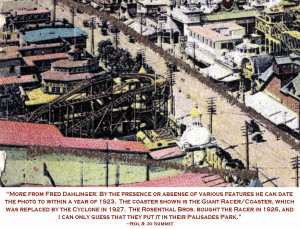 Elmer “Skip” Dundy was born in Omaha, NE, in 1862. Whenever Buffalo Bill Cody was in Omaha, he would visit his friend, the judge, and spend time telling stories to the young Dundy about his adventures. These fascinated Dundee so much that he wanted to become a showman. Dundee went to college at Nebraska State University. After selling the bankrupt Union Pacific Railroad for 20 million, he realized that his skills were in financing. He decided to copy Fred Thompson’s attraction, “Darkness and Dawn,” which Thompson had failed to patent, and applied for a concession for the Buffalo Exposition of 1901.
Elmer “Skip” Dundy was born in Omaha, NE, in 1862. Whenever Buffalo Bill Cody was in Omaha, he would visit his friend, the judge, and spend time telling stories to the young Dundy about his adventures. These fascinated Dundee so much that he wanted to become a showman. Dundee went to college at Nebraska State University. After selling the bankrupt Union Pacific Railroad for 20 million, he realized that his skills were in financing. He decided to copy Fred Thompson’s attraction, “Darkness and Dawn,” which Thompson had failed to patent, and applied for a concession for the Buffalo Exposition of 1901.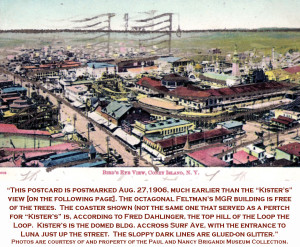
Fred Thompson decided to move to New York City in 1899 to study at the Arts Student’s League. While there he was trying to perfect his “Darkness and Dawn” attraction. He needed a more efficient way of transporting his patrons through the ride. Thompson envisioned an airship traveling in the sky. His thoughts were, “where would I take them?” Then he looked up and saw the moon and said to himself, “that’s it.” Before the night was over Thompson realized he had come up with a new and better attraction, “A Trip to the Moon.”
 In the summer of 1900, Thompson applied for a concession for the Buffalo, NY, 1901 World’s Fair. There he would find that his competitor, Skip Dundy, had copied his “Darkness and Dawn” attraction and also applied for a concession, which Dundee was granted. Thompson, bitter and upset that Dundy would do such a thing, had so much confidence in his “Trip to the Moon” attraction that he approached Dundy about a partnership with his a new idea for an attraction, which he was sure would make ten-times more money than “Darkness and Dawn.” Thompson’s stipulation was that Dundy let him in on his “Darkness and Dawn” concession. Dundy, realizing that “Trip to the Moon” was a first-class attraction, agreed immediately.
In the summer of 1900, Thompson applied for a concession for the Buffalo, NY, 1901 World’s Fair. There he would find that his competitor, Skip Dundy, had copied his “Darkness and Dawn” attraction and also applied for a concession, which Dundee was granted. Thompson, bitter and upset that Dundy would do such a thing, had so much confidence in his “Trip to the Moon” attraction that he approached Dundy about a partnership with his a new idea for an attraction, which he was sure would make ten-times more money than “Darkness and Dawn.” Thompson’s stipulation was that Dundy let him in on his “Darkness and Dawn” concession. Dundy, realizing that “Trip to the Moon” was a first-class attraction, agreed immediately.
The Pan-American Exposition opened on May 20, 1901; however, their attraction was not as yet ready to open until May 23. It was such a success that they doubled the seating capacity by October. It was said that the attraction could have made considerably more money if it had been designed to accommodate a larger capacity. Besides “Trip to the Moon” and “Darkness and Dawn”, the two also operated the “Giant See-Saw”, the “Old Plantation” and several other rides at the fair, controlling a nice portion of the midway.
In 1901, George Tilyou, from Steeplechase Park in Coney Island, visited the Pan-American Exposition, also known as the Buffalo World’s Fair. He went there with the intention of bringing back a new and exciting attraction for his Steeplechase Park.
While at the World’s Fair, Tilyou came across Thompson and Dundy’s “Trip to the Moon” and “Giant See-Saw.” He was so impressed by the attractions that he asked Thompson and Dundy if they would like to bring them to Steeplechase in Coney Island. At the time they didn’t have any other bookings for their attractions until the 1904 St. Louis World’s Fair. Although Dundy would have preferred to wait for the fair, Thompson was eager to go to Coney Island and convinced his partner to do so. They negotiated with Tilyou, who offered them a 60/40 split in their favor, to place their “Trip to the Moon” and the “Giant See-Saw” in Steeplechase Park for the 1902 season. The attractions were both successful and profitable. The overall season of 1902 had a lot of rainy days. Out of 92 days, 70 were rainy, resulting in many of the outdoor attractions suffering. However, despite the rainy season, Steeplechase was the only park that still drew the crowds and made money, thanks to Thompson’s and Dundy’s new attractions.
 Paul Boyton, who owned Sea Lion Park, ran into financial difficulty due to the 1902 rainy season. At the end of the season, Tilyou, Thompson and Dundy were negotiating for 1903. Since “Trip to the Moon” was so profitable, and knowing it was not going to be easy to move, Tilyou offered Thompson and Dundy a 40/60 deal in his favor. Of course, this upset them both and they stormed out of his office. They decided to meet with Paul Boyton to negotiate an offer on his park. They later informed Tilyou that they had just leased the land to Sea Lion Park and they would be moving “Trip to the Moon” and the “Giant See-Saw.”
Paul Boyton, who owned Sea Lion Park, ran into financial difficulty due to the 1902 rainy season. At the end of the season, Tilyou, Thompson and Dundy were negotiating for 1903. Since “Trip to the Moon” was so profitable, and knowing it was not going to be easy to move, Tilyou offered Thompson and Dundy a 40/60 deal in his favor. Of course, this upset them both and they stormed out of his office. They decided to meet with Paul Boyton to negotiate an offer on his park. They later informed Tilyou that they had just leased the land to Sea Lion Park and they would be moving “Trip to the Moon” and the “Giant See-Saw.”
The Giant See-Saw would have been a great expense to dismantle and erect again, so Thompson and Dundy would have preferred to simply sell the ride to Tilyou. Dundy stated, “I would sell you the ride if you weren’t so cheap,” and Tilyou replied back to Dundy, “I will show you how cheap I am – since you are a gambling man, lets flip a coin for it, double or nothing.” Dundy agreed, stating heads or tails. Instead, Tilyou suggested that the coin be tossed closest to the crack on the ground. Dundy tossed the coin first, landing it right next to the crack. Tilyou, in turn, took out a half-dollar tossed it right on the crack. With that, Dundy asked Tilyou if he could keep the half-dollar as a remembrance. The losing of the “Giant See-Saw” and the dismantling of “Trip to the Moon” aggravated both Thompson and Dundy so much that they told Tilyou they would build a park that would put him and Steeplechase out of business.
THE BIRTH OF LUNA PARK
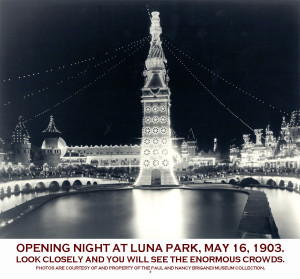 Luna Park would cost an estimated $1 million. The largest investor was John “Bet-a-Million” Gates, who made his money in the steel industry. Luna Park was scheduled to open on May 2, 1903; however, due to construction delays, the park actually opened on Saturday, May 16.
Luna Park would cost an estimated $1 million. The largest investor was John “Bet-a-Million” Gates, who made his money in the steel industry. Luna Park was scheduled to open on May 2, 1903; however, due to construction delays, the park actually opened on Saturday, May 16.
Having spent all their money in the construction of the park, Thompson and Dundy did not even have enough money for change at the ticket booths. They raised a meager $22 for its opening. The general admission to the park was 10 cents, and attractions were extra.
At 8:00 p.m. on May 16, 1903, Thompson and Dundy flipped the switch that illuminated Luna Park for the first time. The people were in absolute awe of the 250,000 lights that outlined the towers, the entrance and minarets. Between 8 and 10 p.m. an estimated 60,000 people streamed through the five entrance gates, each with ornately-carved chariot ticket booths, (carved by Marcus Illions, the master carver of carousels). The chariot boothes were staffed by women dressed in all white gowns with beautiful red feathered hats. The chariots were carved in the Coney Island-style with jewels and elaborate scrolling.
 Marcus Illions had operated a shop at 747 Dean Street in Brooklyn since 1897. He moved to Coney Island around 1903 where his shop was located at New Pier Walk and around 1909 he needed to expand his facility and moved to 2739 Ocean Parkway in Coney Island. Around 1916 Illions merged with William F. Mangels (a great inventor of many amusement devices, including the “Whip,” which he patented in February of 1915), moving into his factory on West 8th Street in Coney Island. Mangels manufactured all the metal parts of the carousel, while Illions created all the wooden carvings.
Marcus Illions had operated a shop at 747 Dean Street in Brooklyn since 1897. He moved to Coney Island around 1903 where his shop was located at New Pier Walk and around 1909 he needed to expand his facility and moved to 2739 Ocean Parkway in Coney Island. Around 1916 Illions merged with William F. Mangels (a great inventor of many amusement devices, including the “Whip,” which he patented in February of 1915), moving into his factory on West 8th Street in Coney Island. Mangels manufactured all the metal parts of the carousel, while Illions created all the wooden carvings.
Together they created the ultimate Coney Island-style carousel. One of these was the Feltman Carousel of Coney Island. Feltman is also credited as the inventor of the hot dog in Coney Island in 1874. Luna Park was a city of white and gold. It started to turn Coney Island from shabby to chic. The first thing that caught your eye was its beautiful skyline with the outline of the buildings against the black canvas night lit by hundreds of thousands of lights – it was breathtaking. The park was a total of 22-acres with 39 spectacular shows. Luna Park was themed around its feature attraction, “Trip to the Moon in Airship Luna III.” It was a journey from the earth to the moon. Once on board the Airship Luna III, the enormous wings flapped up and down like a goose taking off. The airship rocked back and forth, and soon you appeared to be 100 feet in the air. It rose over a panoramic view of Coney Island and passed over Manhattan’s skyline as you rose through the atmosphere towards the moon.
After landing on the moon, the passengers stepped out of the airship and found themselves in a cave on the moon overflowing with stalactites as the midget “selenites” greeted them. As you entered the throne room, you were welcomed by the king who sat on a mother-of-pearl throne flanked by giant bodyguards. The visitors were treated to views of the “Geissler electric fountain,” which displayed all the colors of the spectrum through its splashing waters. At the height of the show there were dancing girls. The lights dimmed, the curtain came down and the show was over.
 Another major attraction in Luna Park was “20,000 Leagues under the Sea.” This illusion would take you on a trip beneath the surface of the seas in an up-to-date [1903] Nautilus. The passengers boarded the submarine. The hatch was closed and the vessel dove into the sea. Through the portholes the passengers could see the monsters of the deep, weeds of vegetation, the skeletons of ships and huge structures of coral. Through the Indian Sea to the cold North Seas the journey was rapid. As the vessel rose, she rammed her nose into an iceberg and was almost wrecked. Upon reaching land the passengers walked to where they could view the Aurora Borealis (northern lights). The atmosphere of the North Pole was as cold as ammonia gas can make it. Eskimos would come out from their dwellings covered in their fur skins eager to great the visitors. The total cost for this illusion in 1903 was approximately $180,000.
Another major attraction in Luna Park was “20,000 Leagues under the Sea.” This illusion would take you on a trip beneath the surface of the seas in an up-to-date [1903] Nautilus. The passengers boarded the submarine. The hatch was closed and the vessel dove into the sea. Through the portholes the passengers could see the monsters of the deep, weeds of vegetation, the skeletons of ships and huge structures of coral. Through the Indian Sea to the cold North Seas the journey was rapid. As the vessel rose, she rammed her nose into an iceberg and was almost wrecked. Upon reaching land the passengers walked to where they could view the Aurora Borealis (northern lights). The atmosphere of the North Pole was as cold as ammonia gas can make it. Eskimos would come out from their dwellings covered in their fur skins eager to great the visitors. The total cost for this illusion in 1903 was approximately $180,000.
There was also the “Great Naval Spectatorium,” a realistic representation of an attack on New York Harbor by the world’s navies. In the center of the park was a heart-shaped lagoon. At one end of the lagoon was the “Chute-the-Chutes,” flat bottom boats that slid down a 45-degree incline into the lagoon. At the other end of the lagoon was the 200-foot tall famous Electric Tower that was beautifully adorned with illuminating lights, so brilliant that it could be seen for miles. The major attractions like “Trip to the Moon” and “20,000 Leagues under the Sea” cost just 25 cents. These types of attractions were of the same magnitude as at a World’s Fair. Luna Park was such an overnight success that by July 4, 1903 Thompson and Dundy had paid back all that they had borrowed. By the end of the season they were both wealthy men.
For the 1904 season the park was expanded by 16 acres making it a total of 38-acres. Along with the purchasing of the additional acreage, Thompson and Dundy purchased the land they were leasing from Paul Boyton. With now over a million twinkling lights, Luna Park became the most romantic amusement park ever built; the true romance of Coney Island.
One of the major attractions that was part of the expansion was “Fire and Flames.” This was the reenactment of the actual burning of four-story brick buildings in a city block. Engine, hook and ladder, and water tower companies, along with 60 firemen under the command of Chief Henry W. Mc Adams (who for 21 years was the chief instructor and drill master of the New York Fire Department) rescued people from the burning buildings. People also leaped from smoke-filled windows into a net below. One thousand people took part in this performance.
Thompson and Dundy were always looking for ways to perfect the park. If an attraction didn’t gross itself back in one season, it was in danger of being replaced. In 1905 the first causality was “20,000 Leagues Under the Sea.” It was replaced by the “Dragon’s Gorge,” an indoor scenic railway roller coaster designed by L.A. Thompson, who invented the roller coaster at Coney Island in 1884. While in route you would see magnificent scenes from the North Pole to the Grand Canal. The drops and dips of an indoor roller coaster increased the thrill, sensation and illusion of traveling faster then you really were, while still being able to take in the scenery. It was such a popular attraction that it remained in the park until the fire in 1944.
With the overnight success of Luna Park, Thompson and Dundy decided to build The Hippodrome, the most spectacular theater in the world on Broadway. Because of their success with Luna Park, John “Bet-a-Million” Gates was more then willing to back this venture. The Hippodrome was located on the west side of the Avenue of the America’s from 43rd to 44th Street. Its creatively designed stage was 110-feet deep by 200-feet wide and could hold up to 600 people. The theater was able to accommodate 5,200 people. The Hippodrome opened on April 12, 1905 with a drama-ballet-circus-opera entitled “A Yankee Circus on Mars” in which the king of Mars buys a bankrupt New England circus.
Thompson and Dundy had a great relationship. Thompson had the creative talent and Dundy was great with finances. Although they both had weaknesses, Thompson for drinking and Dundy for gambling, they both looked out for each other. Thompson married Mabel Taliaferro an actress on February 29, 1906. His devotion to his new wife and her career instead of to Luna Park created a rift between he and Dundy. The following year, on February 5, 1907, Skip Dundy died suddenly of heart failure from severe pneumonia. Without Dundy handling the finances, Thompson’s drinking got worse and his marriage became troubled as he started to lose his direction. He divorced in 1911, and with finances falling into further dismay, he was forced to file for bankruptcy in 1912. He would ultimately lose his beloved Luna Park to the creditors.
Thompson remarried in 1913. He opened an amusement concession at the San Francisco 1915 Panama-Pacific Exposition. Unfortunately, his old-fashion way of thinking could not compete with the new technology of airplanes and the automobile. In 1916 he returned to his beloved Coney Island, broke and depressed. He was given a benefit at Luna Park by his friends upon his return. The benefit raised $30,000 with the intent of building him a home. Unfortunately, just two weeks later he had major surgery for Brights Disease, nearly loosing his life. His health continued to worsen and he needed major surgery again in 1918 and 1919. He died from his illness on June 6, 1919 at the age of 45. He was buried at Woodlawn Cemetery in the Bronx, NY. Penniless, his friends took up a collection to buy a headstone for his grave.
Baron Collier, publisher of advertising, and Collier Magazine took over Luna Park in 1912. He continued to run the park as a family amusement park until 1935. Then Charles Miller took control of the park in 1935 through 1941. In 1941, a group of men, headed by Milton Sheen and William Miller, tried to bring Luna Park back. Unfortunately, on August 12, 1944 Luna Park suffered a devastating fire that ultimately destroyed 90 percent of it. What was left remained open through the 1946 season. Luna Park’s closing ended one of Coney Island’s greatest eras.
CONEY ISLAND’S GREATEST PARKS – Part 2: The Romance of Luna Park.
By Paul and Nancy Brigandi
Reprinted from the July 2008, The Carousel News & Trader magazine.
This is the second in a three part series featuring (arguably) the greatest Amusement Parks ever built, Steeplechase Park, Luna Park and Dreamland, on Coney Island at the turn of the 20th Century.
 Coney Island Part 1 – Steeplechase Park READ FULL STORY >>
Coney Island Part 1 – Steeplechase Park READ FULL STORY >>
Coney Island Part 3 – Dreamland READ FULL STORY >>>








